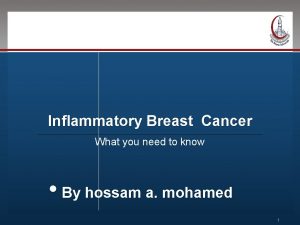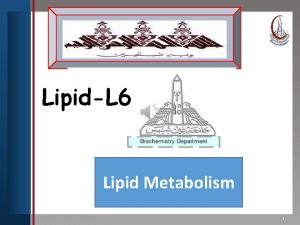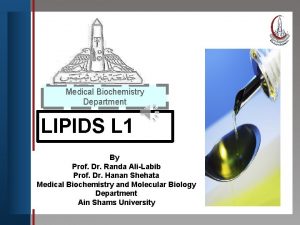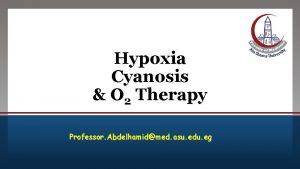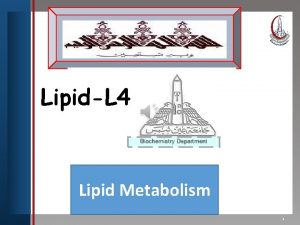Click to edit Master title style Edit Master























- Slides: 23

Click to edit Master title style • Edit Master text styles • Second level Lipid-L 5 • Third level • Fourth level • Fifth level Lipid Metabolism 1

Click to edit Master title style Ketone Bodies Metabolism • Edit Master text styles • Second level • Third level • Fourth level • Fifth level Prof. Dr. Randa Ali-Labib Prof. Dr. Hanan Shehata Medical Biochemistry and Molecular Biology Department 2

Click to edit Master title style Intended Learning Outcomes Edit Master textthis styleslecture , the student should be By • the end of able • Second to • : Thirdlevel • Fourth level 1. Define ketone bodies and related terms • Fifth level 2. Mention ketone bodies blood and urine levels. 3. Explain the process of Ketogenesis. 4. Explain the process of Ketolysis. 5. Discuss the ketone body metabolism in response to the fed state and exercise. 6. Elaborate on ketosis in relation to clinical conditions. ©

Metabolism of ketone Click to edit Master title style bodies v v v Ø v are • What Edit Master textketone styles bodies • Second level What are their blood and urine levels ? • Third level • Fourth level Ketogenesis • Fifth level Ketolysis ketosis

Ketone Bodies Click to edit Master title style • Edit Master text styles • Second level • Third level • Fourth level • Fifth level Ketogenesis : The formation process of KB. Ketosis : Increases the production of KB in the liver. ketonemia : High blood high level of ketone bodies. Ketonuria : High level of KB in the urine.

Ketone Bodies: An Alternate Fuel For Cells Click to edit Master title style • Liver mitochondria can convert acetyl derived from FA • Edit Master text Co. A styles • oxidation Second level into ketone bodies. • Third level Fourth level • The • two functional KB are; • Fifth level Acetoacetate -3 hydroxybutyrate (transported in the blood to the peripheral tissues), but acetone is a nonmetabolized product goes out with breath.

Ketone Bodies: An Alternate Fuel For Cells Click to edit Master title style • The functional water • Edit Master text styles • soluble KB Second level be reconverted to acetyl can • Third level Co. A, which can be oxidized by • Fourth level Co. A • Fifth level the TCA cycle. This utilization process of ketone bodies as fuels is called ketolysis, it occurs in the extra hepatic tissues.

Ketone Bodies: An Alternate Fuel For Cells Click to edit Master title style • Edit Master text styles • The ketone bodies are water • Third level soluble and are transported across the inner mitochondrial membrane as well as across the blood-brain barrier and cell membranes. • Second level • Fourth level • Fifth level

• Thus they be used as a fuel source Click to editcan Master title style by a variety of tissues including the CNS. They are preferred substrates • Edit Master text styles Second level for • aerobic muscle and heart, thus • Third level • Fourth level when they are available. sparing glucose • Fifth level • This allows heart and skeletal muscle to use ketone bodies (ketolysis) as the primary source of energy, thereby preserving the limited glucose supply for use in brain tissue.

Why are KB are important for peripheral tissues sourcetitle of energy? Click to as edita Master style Because they are 1) Soluble intextwater • Edit Master styles do not need lipoproteins or • Secondas level other lipids. albumin • Third level 2) Produced • Fourth in level the liver when acetyl Co. A • Fifth level exceeds the oxidative capacity of the liver 3) Used by extrahepatic tissues ( skeletal, cardiac, muscle and renal cortex). Even the brain can use ketone bodies to meet its energy needs and to spare glucose. 4) Important during prolonged periods of fasting, thus ketone bodies spare glucose

When FA oxidation is high in Click to edit Masterthe title. Liver style (Starvation-Diabetes-Severe muscular exercise). • Edit Master text styles • Second level Acetyl Co. A amount exceed • Third level the capacity of TCA to • Fourth level • Fifth level oxidize it; Why? ? ? Because there is not enough carbohydrates to provide oxaloacetate from the pyrvate carboxylase reaction So, KB are formed from acetyl Co. A.

Synthesis of ketone bodies by the liver: Click to edit Master title style ketogenesis • Edit Master text styles At fast, the liver is full with FA mobilized from fast • Second level Third level adipose • tissue. • Fourth level • Fifth level hepatic acetyl Co. A from FA degradation which inhibits pyruvate dehydrogenase and activates pyruvate carboxylase The OAA produced is used by the liver for gluconeogenesis rather than for the TCA cycle. Therefore, acetyl Co. A goes for ketone body synthesis.

Synthesis of 3 -hydroxy-3 Click to edit. HMG Master title methylglutaryl ) Co. A : style • Edit Master text styles • Second level • Third level • Fourth level • Fifth level 1. By thiolase enzyme acetoacetyl Co. A is formed. takes a 3 rd acetyl Co. A to produce HMG Co. A(also a precursor of cholesterol) NOTE: is the HMG Co. A synthase in the synthesis of ketone bodies, and is present only in the liver

Synthesis of the ketone bodies: Click to edit Master title style HMG Co. A is cleaved to • Edit Master text styles • Second level acetoacetate & acetyl Co. A by HMG Co. A lyase • Third level • Fourth level • Fifth level Acetoacetate can be reduced to 3 hydroxybutyrate with NADH or spontaneously decarboxylated into acetone.

Use of ketone bodies by the Click to edit Master title style peripheral tissues: ketolysis: • Edit Master text styles -Although liver actively produces • Second level the level ketone • Third bodies, it lacks thiophorase , • Fourth level therefore, • is. Fifthunable to use ketone bodies level as fuel. -In contrast, extrahepatic tissues, including the brain but excluding cells lacking mitochondria (e. g. red blood cells), efficiently utilize acetoacetate and 3 hydroxybutyrate in this manner.

Click to edit Master title style • Edit Master text styles • Second level • Third level • Fourth level • Fifth level CAC=Citric acid cycle

Ketone body synthesis in the liver and use in peripheral tissues. Click to edit Master title style • Edit Master text styles • Second level • Third level • Fourth level • Fifth level 3 -OH-butyrate oxidized to acetoacetate by 3 hydroxybutyrate dehydrogenase, giving NADH. Then, Acetoacetate + succinyl Co. A by special transferase (thiophorase) (giving 2 acetyl Co. As which quickly removed to enters TCA for energy).

Click to edit Master title style REGULATION OF KETOGENESIS • Edit Master text styles • Second level • Third level • Fourth level • Fifth level DEPENDING ON: INDIVIDUAL’S PHYSIOLOGICAL STATUS Shortage of Carbohydrates leads to release of free fatty from adipose tissue directly to affect the level of ketogenesis in the liver

Click to edit Master title style • Edit Master text styles • Second level • Third level • Fourth level • Fifth level

Excessive production of ketone bodies in diabetes mellitus leading to ketoacidosis HOW? Click toofedit Master title styleseen in type 1 diabetes. Mechanism diabetic ketoacidosis • Edit Master text styles • Second level • Third level • Fourth level • Fifth level ketogenesis > ketolysis, In severe ketosis, KB blood (ketonemia) may reach 90 mg/dl (versus less than 3 mg/dl in normal individuals). & urine (ketonuria) as high as 5, 000 mg/24 hr.

Click to edit Master title style KB are strong acids so they • Edit Master (p. Ka=3. 5) text styles • Second level of blood. This acidity is dangerous because it impairs the ability of hemoglobin to bind oxygen. • Third level • Fourth level • Fifth level

Click to edit Master title style DIABETIC KETO ACIDOSIS (DKA) • Edit Master text styles • Second level • Third level • Fourth level • Fifth level https: //youtu. be/y. Ic 2 XFNLhm 8 Understand Diabetic Ketoacidosis (DKA) with this clear explanation from Dr. Seheult http: //www. medcram. com

Click to edit Master title style • Edit Master text styles • Second level • Third level • Fourth level • Fifth level
 Informaatika mitteinformaatikutele
Informaatika mitteinformaatikutele Click to edit master title style
Click to edit master title style Click to edit master title style
Click to edit master title style Click to edit master title style
Click to edit master title style Hard edits
Hard edits Click clever click safe
Click clever click safe Internet safety
Internet safety E safety
E safety Click clever click safe
Click clever click safe Master title style
Master title style Master title style
Master title style Click to add title
Click to add title Click to add title
Click to add title Click to add title
Click to add title Title title
Title title Completing reports and proposals
Completing reports and proposals Appendix example apa
Appendix example apa Chicago style title page
Chicago style title page What is a reference page in apa format
What is a reference page in apa format What is a writing style
What is a writing style Cumulative periodic and inverted sentences
Cumulative periodic and inverted sentences What is formal writing style
What is formal writing style Referential vs expressive style
Referential vs expressive style Modified block style letter format example
Modified block style letter format example

























